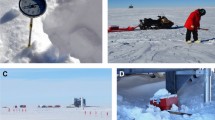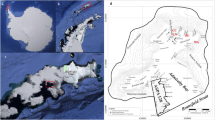Abstract
Mats of coenocytic “snow molds” are commonly observed covering the soil and litter of alpine and subalpine areas immediately following snow melt. Here, we describe the phylogenetic placement, growth rates, and metabolic potential of cold-adapted fungi from under-snow mats in the subalpine forests of Colorado. SSU rDNA sequencing revealed that these fungi belong to the zygomycete orders Mucorales and Mortierellales. All of the isolates could grow at temperatures observed under the snow at our sites (0°C and −2°C) but were unable to grow at temperatures above 25°C and were unable to grow anaerobically. Growth rates for these fungi were very high at −2°C, approximately an order of magnitude faster than previously studied cold-tolerant fungi from Antarctic soils. Given the rapid aerobic growth of these fungi at low temperatures, we propose that they are uniquely adapted to take advantage of the flush of nutrient that occurs at the soil–snow interface beneath late winter snow packs. In addition, extracellular enzyme production was relatively high for the Mucorales, but quite low for the Mortierellales, perhaps indicating some niche separation between these fungi beneath the late winter snow pack.



Similar content being viewed by others
References
Bergero R, Ghirlanda M, Varese GC, Intili D, Luppi AM (1999) Psychro-oligotrophic fungi from Arctic soils of Franz Joseph Land. Polar Biol 21:361–368
Botha A, Paul I, Roux C, Kock JLF, Coetzee DJ, Strauss T, Maree C (1999) An isolation procedure for arachidonic acid producing Mortierella species. Antonie van Leeuwenhoek 75:253–256
Brooks PD, Schmidt SK, Williams MW (1997) Winter production of CO2 and N2O from alpine tundra: environmental controls and relationship to inter-system C and N fluxes. Oecologia 110:403–413
Davidson G, Phelps K, Sunderland KD, Pell JK, Ball BV, Shaw KE, Chandler D (2003) Study of temperature-growth interactions of entomopathogenic fungi with potential for control of Varroa destructor using a nonlinear model of poikiotherm development. J Appl Microbiol 94:816–825
Fletcher LD, Kerry EJ, Weste GM (1985) Microfungi of Mac-Robertson and Enderby Lands, Antarctica. Polar Biol 4:81–88
Heitzer A, Kohler HPE, Reichert P, Hamer G (1991) Utility of phenomenological models for describing temperature dependence of bacterial growth. Appl Environ Microbiol 57:2656–2665
Huelsenbeck JP, Ronquist F, Nielsen R, Bollback JP (2001) Bayesian inference of phylogeny and its impact on evolutionary biology. Science 294:2310–2314
Hughes KA, Lawley B, Newsham KK (2003) Solar UV-B radiation inhibits the growth of antarctic terrestrial fungi. Appl Environ Microbiol 69:1488–1491
James TY, Kauff K, Schoch CL, Matheny PB, Hofstetter V, Cox CJ, Celio G, Gueidan C, Fraker E, Miadlikowska J Lumbsch HT, Rauhut A, Reeb V, Arnold AE, Amtoft A, Stajich JE, Hosaka K, Sung GH, Johnson D, O, ’Rourke B, Crockett M, Binder M, Curtis JM, Slot JC, Wang Z, Wilson AW, Schussler A, Longcore JE, O, ’Donnell K, Mozley-Standridge S, Porter D, Letcher PM, Powell MJ, Taylor JW, White MM, Griffith GW, Davies DR, Humber RA, Morton JB, Sugiyama J, Rossman AY, Rogers JD, Pfister DH, Hewitt D, Hansen K, Hambleton S, Shoemaker RA, Kohlmeyer J, Volkmann-Kohlmeyer B, Spotts R, Serdani M, Crous P, Hughes K, Matsuura K, Langer E, Langer G, Untereiner WA, Lucking R, Budel B, Geiser DM, Aptroot A, Diederich P, Schmitt I, Schultz M, Yahr R, Hibbett DS, Lutzoni F, McLaughlin DJ, Spatafora JW, Vilgalys R (2006) Reconstructing the early evolution of Fungi using a six-gene phylogeny. Nature 443:818–822
Kerry E (1990) Effects of temperature on growth rates of fungi from sub-Antarctic Macquarie Island and Casey, Antarctica. Polar Biol 10:293–299
Ley RE, Williams MW, Schmidt SK (2004) Microbial population dynamics in an extreme environment: controlling factors in talus soils at 3,750 m in the Colorado Rocky Mountains. Biogeochemistry 68:313–335
Lipson DA, Schmidt SK, Monson RK (1999) Links between microbial population dynamics and nitrogen availability in an alpine ecosystem. Ecology 80:1623–1631
Lipson DA, Schadt CW, Schmidt SK (2002) Changes in microbial community structure and function in a tundra meadow following spring snow melt. Microb Ecol 43:307–314
Meyer AF, Lipson DA, Martin AP, Schadt CW, Schmidt SK (2004) Molecular and metabolic characterization of cold-tolerant, alpine soil Pseudomonas, sensu stricto. Appl Environ Microbiol 70:483–489
Meyer AF (2004) Phylogenetic characterization of alpine soil microbial diversity. Ph.D. Dissertation, University of Colorado, Boulder.
Monson RK, Lipson DA, Burns SP, Turnipseed AA, Delany AC, Williams MW, Schmidt SK (2006a) Winter forest soil respiration controlled by climate and microbial community composition. Nature 439:711–714
Nylander JAA (2004) MrModeltest v2. Evolutionary Biology Centre, Uppsala University
Pugh GJF, Allsop D (1982) Microfungi on Signy Island, South Orkney Islands. Br Antarct Surv Bull 57:55–67
Ronquist F, Huelsenbeck JP (2003) MRBAYES 3: Bayesian phylogenetic inference under mixed models. Bioinformatics 19:1572–1574
Saiya-Cork KR, Sinsabaugh RL, Zak DR (2002) The effects of long term nitrogen deposition on extracellular enzyme activity in an Acer saccharum forest soil. Soil Biol Biochem 34:1309–1315
Schadt CW, Martin AP, Lipson DA, Schmidt SK (2003) Seasonal dynamics of previously unknown fungal lineages in tundra soils. Science 301:1359–1361
Schmidt SK, Costello EK, Nemergut DR, Cleveland CC, Reed SC, Weintraub MN, Meyer AF, Martin AP (2007) Biogeochemical consequences of rapid microbial turnover and seasonal succession in soil. Ecology 88:1379–1385
Schmidt SK, Lipson DA (2004) Microbial growth under the snow: Implications for nutrient and alleochemical availability in temperate soils. Plant Soil 259:1–7
Schoolfield RM, Sharpe PJH, Magnuson CE (1981) Nonlinear regression of biological temperature-dependent rate models based on absolute reaction-rate theory. J Theor Biol 88:719–731
Scott-Denton LE, Rosenstiel TN, Monson RK (2005) Differential controls by climate and substrate over the heterotrophic and rhizospheric components of soil respiration. Glob Chang Biol 12:205–216
Tanabe Y, Watanabe MM, Sugiyama J (2005) Evolutionary relationships among basal fungi (Chytridiomycota and Zygomycota): Insights from molecular phylogenetics. J Gen Appl Microbiol 51:267–276
Tokumasu S (1998) Fungal succession on pine needles fallen at different seasons: the succession of surface colonizers. Mycoscience 39:417–423
Weintraub MN, Scott-Denton LE, Schmidt SK, Monson RK (2007) The effects of tree rhizodeposition on soil exoenzyme activity, dissolved organic carbon, and nutrient availability in a sub-alpine forest ecosystem. Oecologia 154:327–338
Wynn-Williams DD (1985) Comparative microbiology of moss-peat decomposition on the Scotia Arc and Antarctic Peninsula. In: Siefried WR, Condy PR, Laws RM (eds) Antarctic nutrient cycles and food webs. Springer, Berlin, pp 204–210
Acknowledgments
This work was supported by grants from the National Science Foundation (MCB-0455606, DEB-0426116). We thank J. Longcore and D.R. Simmons for providing isolates AF016 and AF010.
Author information
Authors and Affiliations
Corresponding author
Rights and permissions
About this article
Cite this article
Schmidt, S.K., Wilson, K.L., Meyer, A.F. et al. Phylogeny and Ecophysiology of Opportunistic “Snow Molds” from a Subalpine Forest Ecosystem. Microb Ecol 56, 681–687 (2008). https://doi.org/10.1007/s00248-008-9387-6
Received:
Revised:
Accepted:
Published:
Issue Date:
DOI: https://doi.org/10.1007/s00248-008-9387-6




